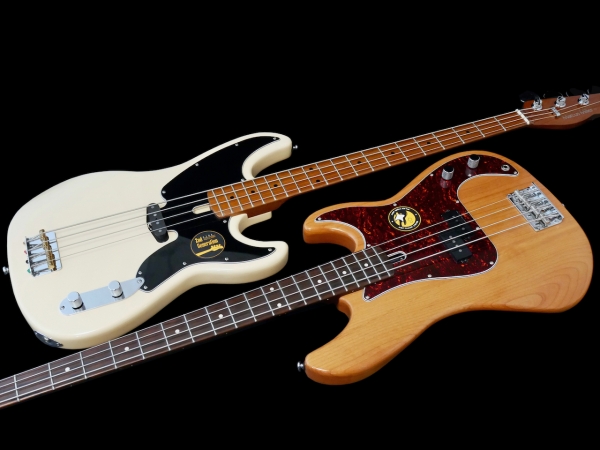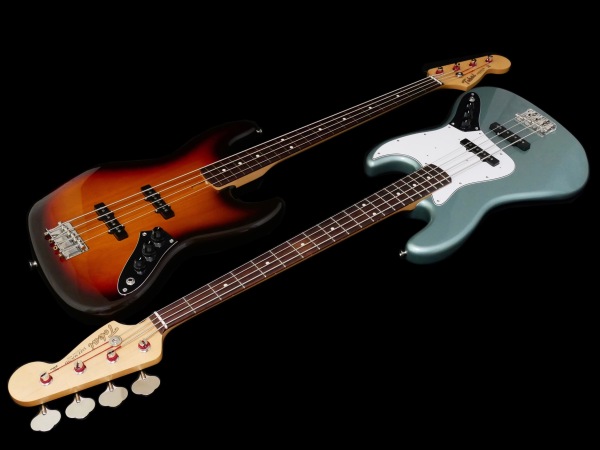Testi on nyt julkaistu. Lue juttu TÄSTÄ.
Sire Marcus Miller D5 & P5 Alder-4 – testi tulossa Rockway-blogiin
• Sire Marcus Miller D5 Alder-4
• Sire Marcus Miller P5 Alder-4
****
The bass parts were played through a Bluetone Bass 200 combo, and recorded with a Shure SM7B microphone plugged into a Cranborne Audio Camden EC2 preamp.
****
The guitar tracks were recorded with a Shure SM7B microphone plugged into a Cranborne Audio Camden EC2 preamp.
• Guitar, stereo left: Gibson Melody Maker SG through an EHX Nano Small Stone into a Bluetone Shadows Jr combo
• Guitar, stereo right: Fender (Japan) 50s Stratocaster into a Bluetone Black Prince Reverb combo
Rickenbacker 4003 vs Höfner 500/1 (Beatle Bass)
Höfner 500/1 (Beatle Bass) vs Rickenbacker 4003
****
The guitar tracks were recorded using a Tech 21 Mop Top Liverpool effect pedal.
• rhythm guitar left (Fender Stratocaster): Channel B with Boost
• rhythm guitar right (Gibson Melody Maker SG): Channel A with Boost
• lead guitar (Epiphone Casino): Channel B with Boost
• reverb added during mixdown
Review: Tokai TJB-55 + TJB-55 FL
The electric bass guitar – and especially a sunburst 1970 Fender Jazz Bass – was my first musical love. My father Jaroslav was the drummer of a professional show band in Germany, and as a child I was lucky to make the occasional trip to rehearsals, recording studios and some afternoon gigs with him. I loved the music, the instruments and the microphones, but most of all I loved to look at the bass player’s (Pavel) Fender Jazz with its huge chrome covers.
I took the roundabout way to becoming a bassist myself, first playing the violin, then the guitar, then the double bass and the piano. In 1985 I bought my first bass guitar – a Japanese Jazz Bass-copy, and I never looked back. That bass is still my go-to instrument.

Over time Tokai Japan instruments have become legendary in their own right. Tokai managed to offer the type of vintage-inspired instruments that guitarists and bassists in the 1970s were craving for, but couldn’t find from US manufacturers. To this day Tokai stands for top quality at a musician-friendly price.
****

You could call the fretless Tokai TJB-55 FL (1.238,– €) Tokai’s unofficial Jaco Pastorius ”signature model” judging by its looks.

The fretted Tokai TJB-55 (999,– €) we received for this review is finished in a gorgeous metallic finish, called ocean turquoise metallic, which sits somewhere between green and silver.
The basic ingredients in both TJB-55 versions are high quality, traditional choices. True to their 1960s designation, both instruments feature alder bodies paired with maple necks.

The ribcage chamfer is very deep and soft.
In contrast to vintage basses both necks here sport a thin satin finish. This is a welcome nod to most modern bass players, who prefer matte finishes to the glossy necks from way back, which are often described as a bit sticky.


The machine heads on the TJB-55s are Gotohs which manage to retain a vintage look, while being smaller and lighter than original Klusons, Fenders or Schallers on vintage basses.

The regular Tokai TJB-55 sports 20 medium-sized frets in its beautiful rosewood fingerboard. The fretwork is top notch.

The fretless TJB-55 FL features fret lines made from maple; a welcome addition, especially for the occasional fretless player.
On forums – where else – you repeatedly find claims that rosewood might be too soft a wood for a fretless bass and roundwound bass strings. I own a well-loved and much-played 1976 Fender Precision Fretless, which – despite some light grooves in the ‘board – still plays fine.

Gotoh’s well-made version of an early-Seventies Fender bridge fits the bill on both the TJB-55 and the TJB-55 FL.

The legendary status of Jazz Basses is founded on two things – their great ergonomic properties, and their juicy yet transparent single-coil pickups.
Both Tokais come with a pair of the company’s own, excellent JB-Vintage Mark III pickups that promise vintage-style tones. The bridge pickup is reverse wound/reverse polarity to the neck unit, so the combination of both pickups is humbucking.

The quality of the electronic parts and the neatness of the wiring is a sight for sore eyes. Tokai even goes as far as equipping the pickups with period-correct (early-Sixties) wires with waxed cloth insulation.

A high-quality gig bag comes supplied with both models. Inside the side pocket of the TJB-55 FL’s bag you will find a three-ply white pickguard, should you prefer that look.
****

I don’t know how Tokai does it, but it has managed – once again – to imbue both basses with heaps of that proverbial “vintage mojo”, even though we’re looking at brand-new instruments here. The combination of top notch parts, along with the company’s proven track record, seems to make for a fantastic mix in both TJB-55s.
These two Tokais offer the best of all the great features of an early-Sixties Jazz Bass. The workmanship on both TJB-55s is second to none, the playability is very comfortable, and the sounds deliver big time. If you’re looking for some top-drawer “Jazz action”, you should definitely try one of these basses out.

****

Testipenkissä: Tokai TJB-55 + TJB-55 FL
Sähköbasso – ja etenkin sunburst-värinen vuoden 1970 Fender Jazz Bass – oli elämäni ensimmäinen rakkaus. Isäni Jaroslav oli ammattirumpali saksalaisessa showbändissä, ja sain lapsena olla välillä mukana harjoituksissa, studioissa ja joissakin iltapäiväkeikoilla. Rakastin musiikkia, soittimia, mikrofoneja – mutta pääasiallinen katseenvangitseja minulle oli orkesterin basistin Pavelin Jazz-basso.
Kävin kiertotietä pitkin basistiksi; olin ensin viulisti, sitten kitaristi ja vielä kontrabasisti, mutta ensimmäinen kunnon soitin, jonka hankin omilla rahoillani vuonna 1985 oli japanilainen Jazz-basson kopio. Tämä satojen keikkojen basso on yhä minun lempisoitin.

Japanilaisista Tokai-soittimista on tullut ajan myötä legendaarisia. 1970-luvun lopussa Tokai tarjosi juuri sellaisia laadukkaita, vintage-tyylisiä sähkökitaroita ja -bassoja, joita soittajat halusivat, mutta joita ei silloin saatu Yhdysvalloista. Mutta myös nykyään japanilaiset Tokai-soittimet tarjoavat muusikoille laadukasta vintagea soittajalle ystävällisellä hintalapulla.
****

Nauhaton Tokai TJB-55 FL (1.238,– €) on kuin Tokain epävirallinen ”nimikkomalli” Jaco Pastoriukselle, legendaariselle nauhattoman Jazz-basson soittajalle.

Tämän testin nauhallinen Tokai TJB-55 (999,– €) on viimeistelty upealla metallivärillä – ocean turquoise metallic – joka on sinertevän hopea.
Molemmissa TJB-55-versioissa perusainekset ovat hyvin laadukkaita. Kuuskytluvulle uskollisesti bassojen rungot ovat leppää, kun taas ruuvikaulat veistetään kovasta vaahterasta.

Rungon mukavuusviiste on hyvin syvä ja mukava.
Kaulan viimeistely poikkea hieman vintage-reseptistä, sillä kumpikin basso tarjoaa ohuen mattapinnan muusikon otekädelle. Useat nykybasistit pitävät 1950-70-lukujen kiiltävän viimeistelyn liian ”tahmealta”, minkä vuoksi Tokai-bassojen satiinipintainen matta on hyvä valinta.


TJB-55-bassojen virittimet tulevat Gotoh:n mallistosta, ja ne yhdistävät onnistuneesti vintage-Schallereiden ulkonäköä hieman pienemmällä painolla. Lopputulos on entistäkin parempi balanssi.

Tokai TJB-55:n ruusupuiseen otelautaan on istutettu 20 medium-kokoista nauhaa. Nauhatyö on ensiluokkaista.

Tokai TJB-55 FL:n otelautaan taas on asennettu vaahteralinjat, jotka helpottavat – etenkin aloittelevan – fretless-basistin osumatarkkuutta.
Jotkut väittävät, että nauhatomaan bassoon ei sovi ruusupuuta, koska tämä puulaji olisi muka liian pehmeä nykyaikaiselle roundwound-kielille. Oma nauhaton bassoni on kuitenkin paljon soitettu vuoden 1976 Fender Precision Fretless, ja vaikka sen ruusupuuotelaudassa on pieniä uria, se ei haittaa menoa – ainakaan vielä – lainkaan.

Laadukas versio 1970-luvun Fender-tallasta istuu luonnollisesti erittäin hyvin vintage-tyliseen TJB-55 ja TJB-55 FL:ään.

Loistavan erogonomian lisäksi yksikelaisten mikrofonien maukas sointi seisoo Jazz-basson suosion keskipisteessä.
Molemmpiin Tokai-bassoihin on asennettu firman kuuluisia JB-Vintage Mark III -mikrofoneja, jotka lupaavat autenttisia 1960-luvun Jazz Bass -soundeja. Tokain mikit toimivat yhdessä käytettyinä humbuckerin tapaan hurinattomasti.

Tokai menee jopa niin pitkään, että mikrofonien johdot ovat 1960-luvun alussa käytetty malli, jossa eristys on hoidettu vahalla kyllästetyllä kangaskudoksella.

Laadukas keikkapussi kuuluu Tokai TJB-55 -bassoissa hintaan. TJB-55 FL:n mukaan tulee myös kolmikerroksinen valkoinen pleksi, jota voi asentaa itse, jos basson ”alaston” ulkonäkö ei jostain syystä miellytä.
****

En tiedä miten Tokai Japan sen tekee, mutta sekä TJB-55:ssä että TJB-55 FL:ssä on runsaasti sitä kuuluisa ”vintage-mojoa”, vaikka kyseessä on upouudet sähköbassot. Ilmeisesti näissä soittimissa kaikki laadukkaat osat ja firman pitkä kokemus vintage-kopioissa yhdistyvät suvereenisti laadukkaan lopputulokseen.
Jazz-bassojen parhaat ominaisuudet ja niiden klassisimmat soundit on onnistettu ikäänkuin tislaamaan näihin huippubassoihin. Tokain toteutus on kauttaaltaan laadukas, sekä bassojen soundit ja soitettavuus ensiluokkaista. Kannattaa siis ehdottomasti tutustua Tokai TJB-55 -bassoihin, jos on kiinnostunut pro-laadun Jazz-bassoista.

****

Tokai TJB-55 FL – Wherever I Lay My Hat
The demo is based on Pino Palladino’s classic bass part, as heard on Paul Young’s 1983 hit ”Wherever I Lay My Hat”.
Listen to the original HERE.
Find more information on the Tokai TJB-55 FL HERE.
I recorded the bass straight into my Universal Audio Volt2 interface. The light chorus was added in the DAW.



Guitar Porn: Tokai TJB-55 & TJB-55 FL


The fretted Tokai TJB-55 takes the first verse, and the fretless TJB-55 FL plays in the second verse.
The bass tracks have been recorded using a Cranborne Audio Camden EC2 preamp and a Universal Audio Volt2 interface.



Tokai TJB-55 & TJB-55 FL ++ Testi tulossa ++ Working on a review
The fretted Tokai TJB-55 takes the first verse, and the fretless TJB-55 FL plays in the second verse.
The bass tracks have been recorded using a Cranborne Audio Camden EC2 preamp and a Universal Audio Volt2 interface.

Left: Tokai TJB-55
Right: Tokai TJB-55 FL




